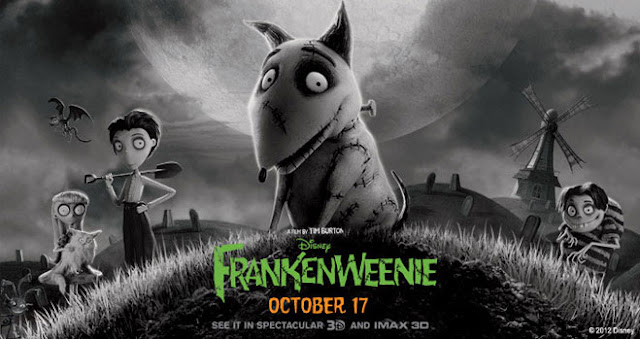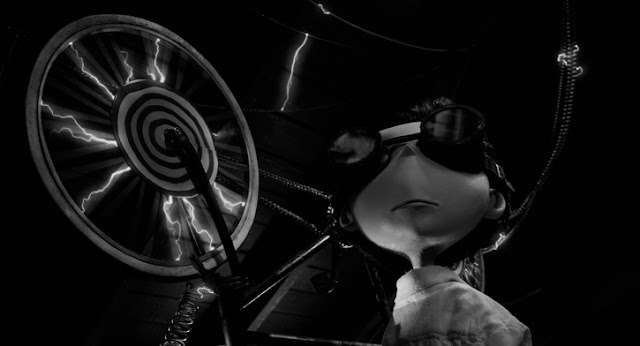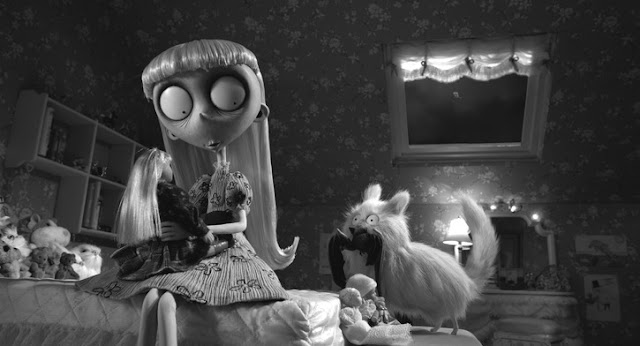Trevor Hogg chats with Richard Baker and Matt Bristowe from Prime Focus World about their work on Frankenweenie...
When a young animator made a live-action short film about a boy who resurrects his dead dog, his association with Disney came to an end as the dark tale was deemed too scary for children; years later the legendary animation studio rekindled a creative partnership with Tim Burton (Big Fish) which has resulted in a reimagining of Frankenweenie (2012) as a black and white stop-motion animated feature length film in 3D. “It’s quite remarkable how true the animated feature is to the original,” observes Matt Bristowe, the Joint Managing Director of Stereo Conversion for Prime Focus World. “There are key scenes, such as where Sparky gets run over, that play just as they do in the short; it’s nice to see that continuity.” Richard Baker, the Creative Director of Stereo Conversion for Prime Focus World, agrees with his colleague. “Yes, the original live-action film was a reference, and it’s amazing how close to the original some of the shots in the new film are. Also, you can see how the detail and the set design have carried through from the original to the stop-motion version. This story is obviously close to Tim’s heart, and Frankenweenie was a labour of love for him.”
“The stop-motion animation industry is not huge, and Matt Bristowe had previously worked on other stop-motion projects with Frankenweenie producer Alison Abbate, as well as on Corpse Bride [2005] and Fantastic Mr. Fox [2009],” explains Richard Baker. “We produced some test sequences for Tim [Burton] back in November 2010, and were selected to provide the conversion for Frankenweenie on that basis. We’ve been attached to the project from that point onwards [stop-motion films have a longer gestation period than live action!].” Matt Bristowe adds, “Richard Baker and I work closely together on all aspects of our 3D projects. Tim would come in once a month to review sequences, and because we’d established the requirements and look for the stereo early on. Richard was creatively in charge of the conversion which went smoothly. As the primary client-facing production executive on the project, my main role was to manage the global conversion system for the entire project. This principally entailed working with the London and Mumbai teams to ensure that the production stayed on track throughout the conversion process, as well as reassuring the studio that it would deliver on time!” In regards to how the various tasks were divided between the two facilities, Bristowe remarks, “The conversion teams in London and Mumbai are very much extensions of each other and the work tends to be allocated based on skill sets and strengths. Some scenes are particularly VFX heavy and some include finer points of detail. The scenes are allocated to whichever teams have the specialism in that area, be that in Mumbai or London or indeed in Vancouver. Also, our supervisors working under Richard were constantly travelling between the studios, helping Richard to ensure consistency across the whole project.”
“I had a number of early meetings with Tim Burton, to discuss both his expectations and my thoughts on the 3D for Frankenweenie,” says Richard Baker. “As the sole conversion partner on the movie, PFW was given full creative control of the 3D; these meetings were important in establishing Tim’s trust in my vision for the use of depth in the movie. After the first review it became clear that Tim was happy, and confident that I was taking the 3D in a direction that was in-line with his creative vision; from that point onwards, he really gave me creative freedom to treat the depth as I saw fit. Tim Burton, [Visual Effects Supervisor] Tim Ledbury and I would meet and review sequences about once a week; the process worked smoothly with all three of us generally in agreement.” Matt Bristowe, who was involved in making Wrath of the Titans [2012] and Harry Potter, notes, “From a creative point of view we’re learning all the time. Those two shows, and many others like them, helped us to build the skill levels of the artists and the technology overall. You’re working on a big studio picture with certain expectations and tight deadlines; having said that, Frankenweenie was a different type of show to Wrath or Potter. The nature of the stop-motion animation means long, lingering shots which allow your eye to take in the scene; this meant that much more attention had to be paid to the fine detail, which on a live-action show may have been lost in a quick pan or motion blur.” Bristowe remarks, “We had more latitude and creative freedom, in that respect, than we would normally have with a live-action show; it allowed us to play with the stereo in the sculpting of the characters’ big heads and enormous eyes.” Baker believes, “This [project] required pixel perfect treatment of the depth to allow the full detail of the amazing sets to shine through on-screen. This conversion was about enhancing these environments and bringing them alive.”
“The black and white aspect of the movie, the high-contrast edges of some elements in the scenes, and the lack of motion blur inherent in stop-motion animation, meant that there was a problem with strobing on some shots; for example, on Victor’s legs when he was running,” reveals Richard Baker. “We added character motion blur to this type of sequence. There were some similar issues when the camera was moved fast, and on the long panning shots, for which we would track the shot and add camera motion blur. During the final grade, Tim lifted the blacks and lessened the contrast, which also helped considerably with these issues.” The effect of stereography has on the sense of perception allowed for scenes to be creatively manipulated. “3D doesn’t have a tendency to miniaturize objects by itself,” states Matt Bristowe. “It’s about how you control the depth, and with stereo conversion, you have full creative control. We actually used this deliberately in Frankenweenie in the scene with the giant turtle. We intentionally used the depth to miniaturize the smaller characters to emphasize the giant scale of the turtle.” Baker says, “I was careful to ensure that the 3D enhanced the storyline and the emotions of the film at every step, and was never gimmicky or unnecessary. At PFW, we see depth as another creative storytelling tool; just as the director can use the grade, the edit, and the score to heighten the emotions of the story we can use the depth. At the start of a project, I worked through the film and produced a depth script, detailing how the depth would be used throughout the movie for dramatic effect. In Frankenweenie, the depth is very much tied to the score – a good indicator of dramatic moments in the film. There are no flat sequences in Frankenweenie, but there are shallower scenes that may proceeded key sequences which called for much more depth, such as Victor in the attic, or the windmill sequence at the end of the film. Of course there are stand-out moments which are designed to really use the 3D, such as when the cat jumps out at Victor in the graveyard.”
“The biggest challenge, from a production point of view, was probably transitioning our artists seamlessly from Wrath straight into Frankenweenie,” states Matt Bristowe. “These shows are so different in terms of creative content, and the approach to the films was also different. I had to help the artists make this leap without falling behind and hindering the progress of the new show. We overcame the challenge by starting the show early in London during a prep-phase, then taking key supervisors and artists out to India as the Indian artists segued off other projects and onto the new show. We also had the Indian supervisor, Jimmy Phillips, come out to London and spend two months with Richard Baker at the start of the project, to ensure that he had a full understanding of what Richard wanted creatively from the start; he was able to take that back to the Mumbai teams. It’s about first hand communication.” Richard Baker says, “Every scene in every show has its own challenges, but there is no single aspect of Frankenweenie that I would single out. It was an absolute pleasure to work on this movie. The creative control I was given, and the trust placed in me and the PFW team by Tim and Disney, made this process extremely rewarding and creatively fulfilling.” Bristowe remarks, “I’m proud of the whole show. I guess from a production point of view, I’m proud that we delivered such a huge number of shots on time and to the satisfaction of Tim and his team.”
When questioned as to how he sees 3D evolving and whether the technology will become as accepted as colour and sound, Richard Baker answers, “In terms of the filmmakers themselves, I believe 3D is already becoming widely accepted and embraced as a creative tool to be used sympathetically with the sound and the grade; this will only continue. As with visual effects which have developed to the point that they are an integral part of the filmmaking process for many films, 3D is best employed early in the process; when engaged at an early stage as on Frankenweenie, we can collaborate with the director and the filmmaking team to design the shots and ensure that the 3D is in-line with their vision for the film. In terms of the future, the quality of the 3D will keep improving – whether natively captured or converted.” For Matt Bristowe, the technology requires artistic forethought. “The key to me is not to let 3D become a process. You shouldn’t think you can press a button to produce good 3D. It is a creative tool, and there are more and more filmmakers using it as a creative tool. Perhaps this hasn’t come across to the public yet, who see another film in 3D, but there are a gamut of approaches with 3D. Just as you can elicit different responses and emotions for a particular scene through the colour grading, so you can through the 3D. I think that realization of this will take time – but it will become more obvious as more good 3D movies are released.”
Many thanks to Richard Baker and Matt Bristowe for taking the time to be interviewed.
Trevor Hogg is a freelance video editor and writer who currently resides in Canada.
When a young animator made a live-action short film about a boy who resurrects his dead dog, his association with Disney came to an end as the dark tale was deemed too scary for children; years later the legendary animation studio rekindled a creative partnership with Tim Burton (Big Fish) which has resulted in a reimagining of Frankenweenie (2012) as a black and white stop-motion animated feature length film in 3D. “It’s quite remarkable how true the animated feature is to the original,” observes Matt Bristowe, the Joint Managing Director of Stereo Conversion for Prime Focus World. “There are key scenes, such as where Sparky gets run over, that play just as they do in the short; it’s nice to see that continuity.” Richard Baker, the Creative Director of Stereo Conversion for Prime Focus World, agrees with his colleague. “Yes, the original live-action film was a reference, and it’s amazing how close to the original some of the shots in the new film are. Also, you can see how the detail and the set design have carried through from the original to the stop-motion version. This story is obviously close to Tim’s heart, and Frankenweenie was a labour of love for him.”
| Image may be NSFW. Clik here to view.  |
| Matt Bristowe |
| Image may be NSFW. Clik here to view.  |
| Richard Baker |
“The biggest challenge, from a production point of view, was probably transitioning our artists seamlessly from Wrath straight into Frankenweenie,” states Matt Bristowe. “These shows are so different in terms of creative content, and the approach to the films was also different. I had to help the artists make this leap without falling behind and hindering the progress of the new show. We overcame the challenge by starting the show early in London during a prep-phase, then taking key supervisors and artists out to India as the Indian artists segued off other projects and onto the new show. We also had the Indian supervisor, Jimmy Phillips, come out to London and spend two months with Richard Baker at the start of the project, to ensure that he had a full understanding of what Richard wanted creatively from the start; he was able to take that back to the Mumbai teams. It’s about first hand communication.” Richard Baker says, “Every scene in every show has its own challenges, but there is no single aspect of Frankenweenie that I would single out. It was an absolute pleasure to work on this movie. The creative control I was given, and the trust placed in me and the PFW team by Tim and Disney, made this process extremely rewarding and creatively fulfilling.” Bristowe remarks, “I’m proud of the whole show. I guess from a production point of view, I’m proud that we delivered such a huge number of shots on time and to the satisfaction of Tim and his team.”
When questioned as to how he sees 3D evolving and whether the technology will become as accepted as colour and sound, Richard Baker answers, “In terms of the filmmakers themselves, I believe 3D is already becoming widely accepted and embraced as a creative tool to be used sympathetically with the sound and the grade; this will only continue. As with visual effects which have developed to the point that they are an integral part of the filmmaking process for many films, 3D is best employed early in the process; when engaged at an early stage as on Frankenweenie, we can collaborate with the director and the filmmaking team to design the shots and ensure that the 3D is in-line with their vision for the film. In terms of the future, the quality of the 3D will keep improving – whether natively captured or converted.” For Matt Bristowe, the technology requires artistic forethought. “The key to me is not to let 3D become a process. You shouldn’t think you can press a button to produce good 3D. It is a creative tool, and there are more and more filmmakers using it as a creative tool. Perhaps this hasn’t come across to the public yet, who see another film in 3D, but there are a gamut of approaches with 3D. Just as you can elicit different responses and emotions for a particular scene through the colour grading, so you can through the 3D. I think that realization of this will take time – but it will become more obvious as more good 3D movies are released.”
Production stills © Disney. All rights reserved. Images courtesy of Disney and Prime Focus World.
Visit the official websites for Frankenweenie and Prime Focus World; be sure to check out Trevor's Tim Burton filmmaker profile, Freakishly Clever.
Many thanks to Richard Baker and Matt Bristowe for taking the time to be interviewed.
Trevor Hogg is a freelance video editor and writer who currently resides in Canada.










